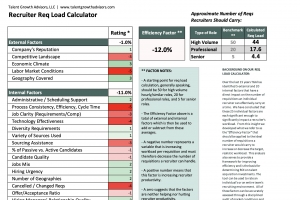Attracting Top Talent: The Way You’re Thinking About Candidates is All Wrong

Most organizations have been taking the same approach to talent issues for many, many years. Consider hiring requisitions being handled in largely the same way, spreading limited training resources as thinly and evenly as possible, and treating candidates as if they're lucky we've chosen to interview them.
But while this status quo is maintained, the world around us has changed radically. Let's highlight the dramatic change in how candidates - especially the most elite candidates - think about the hiring process. We refer to these elite candidates as "human capital investors" or "human capitalists" - and here's why:
Human capital investors think about employment the way financial investors think about buying stock. They expect a mix of “capital growth and dividend payout” consistent with their investment goals and risk tolerance.
Capital growth for the human capitalist means growth in those things that increase their capacity for generating future personal returns. These investors have an expectation of acquiring certain experience, knowledge and skills as a result of their investment - that is, their employment - decision. A track record of successfully “investing” in reputable companies adds fuel to their growth potential.
“Dividend payout” for the human capitalist means economic reward in all forms including salary, short and long-term incentives, and benefits. Clearly for the human capitalist, “dividend payout” is baseline and must be competitive but will not often win the day on its own. The reason for this is quite rational:
For most of a human capitalist’s career, “capital growth” has greater value than “dividend payout” because of its direct impact on future earnings potential. This impact can easily be multiple times current earnings. So the potential for acquiring knowledge, experience, and skills (and the risk of that not being so) weighs heavily on the employment decision and commitment of today’s human capitalists.
This does not mean that today’s relationship will only last three years, but it does mean that the human capitalist routinely reassesses their situation. This is not an announcement but rather a self-assessment of where they stand versus where they expected to be when their investment was initially made. Often, the first assessment occurs somewhere between the 2 to 3 year mark. What becomes visible are the decisions to pack it in and make a different investment. The decisions to reinvest are not as visible even though they have been made. This same cycle is really no different from that of a financial investor, but it is even less visible. Rest assured, every 3 years or so, the human capitalist will decide to re-sign or resign.
These candidates consider alternative investments and compare the potential returns to those of their current investment. Different from the financial investor, to state the obvious, the human capitalist investor as a practical matter can only invest in one company at a time. Ultimately they make a decision to “invest,” keeping in mind the timeframe they are willing to wait before seeing that investment bear fruit. At the end of the day, time is the constraint for this investor - their number of years are limited, so each one counts.
Like financial investors, the intent and strategies of human capitalist investors comes in a variety of flavors. You have your short-term and long-term investors, high yield (risk) and growth-oriented investors, and perhaps even an argument for day-traders. Which investors do you want? How do you attract and retain those investors? Like any corporation raising and retaining financial capital, it is important to have a clear view of who you are and what type of investor best fits your needs. There are countless products and services, case studies, and seminars hawking approaches to building employment branding and employment value propositions. In reality, you need look no further than your Investor Relations team to find the best strategies for attracting and retaining critical talent.
You may also want to read An Annual Plan to Showcase HR as an Investment, Not a Cost. Want to learn more about how to attract the human capital investors your company needs? Pre-order our new book: Talent Valuation: Accelerate Market Capitalization through Your Most Important Asset.
Share this Article
Learn more about our unique approach to Talent Strategy Formulation.



